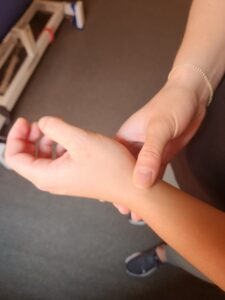What is DeQuervain’s Tenosynovitis?
Description
DeQuervain’s Tenosynovitis, common in office workers, new parents, and jobs requiring repeated thumb and wrist movements, is a condition whereby the tendons of the thumb side of the wrist become inflamed from an increase in repetitive wrist and thumb movements. Pain generally occurs upon movement of the wrist and thumb. There can also be thickening and swelling around the thumb side of the wrist.
What causes it?
DeQuervain’s is a tendon-based injury from a sudden increase in repetitive load to the thumb and wrist muscles.
It is very common in new parents- due to the increase load on the thumb and wrist muscles when holding and lifting a new baby – especially when the thumbs are pointed up. Other typical activities that can cause pain include transitioning to a desk-based job with a lot of mouse work, reaching to grasp something with an open thumb or activities involving repeated turning or flipping.
How do I know if I have DeQuervain’s?
DeQuervain’s will often become apparent due to pain and swelling over the thumb side of the wrist. The pain will sometimes travel down into the thumb or up into the forearm. The pain can increased when lifting your thumb or stretching your thumb down towards your 5th finger.
This condition can be described as a pulling, or burning sensation with a constant ache. This pain will be worse with activities involving repeated lifting, twisting or grasping movements – i.e. Turning open a water tap, opening a jar lid, lifting and holding a weight.
Clicking and flicking sounds may also be apparent if the swelling around the tendons is severe. It is possible to have no pain, but still have DeQuervain’s with just swelling and these sounds apparent.
What else could be causing my pain?
Other conditions may present with similar symptoms to DeQuervain’s. It is important to get a diagnosis from a Physiotherapist. These other conditions can include:
- Osteoarthritis of the thumb (first carpometacarpal joint)
- Trigger thumb
- Fractures of the scaphoid or radial styloid bones
- Watenberg’s syndrome (radial nerve entrapment)
- Intersection syndrome (a tendon injury to the wrist extensors)
Treatment
Treatment aims to avoid overloading the thumb and wrist tendons – and avoiding aggravating activities. The aim of treatment in the initial stages is to reduce the pain and swelling around the tendon sheath. Treatment can include:
- Use of thumb splints
- Ice/heat packs
- Education regarding avoiding repetitive or aggravating movements
- Strengthening exercises
- Mobilisations
- Taping
- Referral to a musculoskeletal doctor for ultrasound imaging and possibly a corticosteroid injection.
Written by Petra Ruhl, Physiotherapist
Please click here if you would like to book an appointment with a physio.
References
- ↑ Pagonis T, Ditsios K, Toli P, Givissis P, Christodoulou A. Improved corticosteroid treatment of recalcitrant de Quervain tenosynovitis with a novel 4-point injection technique. The American journal of sports medicine. 2011 Feb;39(2):398-403.
- ↑ Jump up to:2.0 2.1 2.2 2.3 Ashurst JV, Turco DA, Lieb BE. Tenosynovitis caused by texting: an emerging disease. Journal of Osteopathic Medicine. 2010 May 1;110(5):294-6.
- ↑ Jump up to:3.0 3.1 3.2 González-iGlesias J, Huijbregts P, Fernández-de-Las-Peñas C, Cleland JA. Differential diagnosis and physical therapy management of a patient with radial wrist pain of 6 months’ duration: a case report. journal of orthopaedic & sports physical therapy. 2010 Jun;40(6):361-8.


